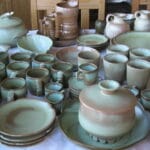Roll top desks are experiencing a surge in popularity, blending vintage charm with modern practicality. Finding the perfect one can be straightforward with the right guidance. This guide offers comprehensive insights into the history, types, buying considerations, and maintenance tips for these elegant and functional desks.
Roll Top Desk: A Comprehensive Buyer’s Guide
Roll top desks, known for their space-saving design, seamlessly blend nostalgia with modern functionality, making them a stylish and practical addition to any home office or workspace. This guide covers everything you need to know before purchasing a roll top desk, from its historical roots to practical selection and care tips.
A Journey Through Time: The History of the Roll Top Desk
The narrative of the roll top desk begins in the 19th century, a period marked by the burgeoning need for efficient organization in both businesses and professional environments. Its design, which effectively conceals documents and supplies, quickly garnered favor. Early iterations, often fashioned from rich, dark woods, beautifully reflected the Victorian era’s penchant for ornate detailing. As the 20th century dawned, designs evolved towards simpler, more streamlined aesthetics, mirroring the clean lines and functional focus of modernism. Today, the market offers a wide array of choices, from ornate antique reproductions to sleek, minimalist designs, underscoring the enduring appeal and adaptability of this timeless piece.
Decoding the Types: Finding Your Ideal Match
Selecting the right roll top desk involves understanding its key features. Familiarizing yourself with these elements will guide you to the perfect match for your specific requirements and aesthetic preferences.
| Feature | Options | Considerations |
|---|---|---|
| Material | Solid wood (oak, cherry, maple, walnut, etc.), Engineered wood (MDF, plywood) | Solid wood provides superior durability, natural beauty, and potentially higher resale value. Engineered wood offers affordability and consistency. Consider the overall aesthetic and your budget. |
| Style | Traditional, Modern, Victorian, Minimalist, Farmhouse, Industrial, Antique | Reflect on your existing décor and personal taste. A traditional desk complements a period home, while a minimalist design seamlessly integrates into a contemporary space. Antique desks offer unique character and historical significance. |
| Construction | Handcrafted, Mass-produced | Handcrafted desks are unique with superior detailing and quality but typically come at a premium price. Mass-produced desks offer affordability and accessibility, suitable for budget-conscious buyers. |
| Size/Dimensions | Small, Medium, Large; Consider Height, Width, and Depth | Accurately measure your workspace to ensure the desk fits comfortably. Consider the desk’s height for ergonomic comfort. Ensure the roll-top mechanism operates smoothly without obstruction. A desk too large can overwhelm a small room, while a desk too small may not provide adequate workspace. |
| Storage | Drawers, Cubbies, Shelves, Hidden Compartments | Assess your specific storage needs. Consider the number and type of drawers (e.g., file drawers, pencil drawers), the configuration of cubbies and shelves, and whether you require hidden compartments for secure storage. |
| Features | Keyboard Tray, Cable Management, Hutch, Locking Mechanism | Consider practical features that enhance functionality. A keyboard tray can improve ergonomics, cable management systems keep cords organized, a hutch provides additional storage and display space, and a locking mechanism offers added security. |
| Finish | Natural, Stained, Painted | The finish enhances the wood’s natural beauty and protects it from wear. Natural finishes showcase the wood grain, while stains add color and depth. Painted finishes offer versatility and can complement various décor styles. Ensure the finish is durable and resistant to scratches and stains. |
Your Ultimate Roll Top Desk Buying Guide: Making an Informed Choice
Selecting a roll top desk involves balancing style, functionality, and cost. This step-by-step guide will help you navigate the selection process:
- Establish Your Budget: Determine your spending limit before exploring options. Prices vary significantly, from budget-friendly desks to high-end handcrafted pieces.
- Material Matters: Solid wood offers durability and a luxurious feel but is more expensive. Engineered wood is affordable, while metal desks offer a modern aesthetic but may lack ample storage.
- Measure Your Space: Accurately measure your available space, considering the desk’s dimensions when the roll top is both open and closed. Allow adequate room for comfortable movement.
- Assess Storage Needs: Evaluate your storage requirements and choose a desk with the appropriate number and type of drawers, compartments, and shelves.
- Select a Style: Choose a style that complements your existing décor and reflects your aesthetic preferences. Consider whether you prefer a classic, modern, or eclectic look.
- Ergonomics: Ensure the desk height promotes good posture and reduces strain. Consider adjustable height options or the addition of a keyboard tray for optimal comfort.
- Sustainability: Opt for desks made from sustainably sourced wood, certified by organizations such as the Forest Stewardship Council (FSC).
- Select a Retailer: Explore online marketplaces, specialty furniture stores, and antique shops. Consider the retailer’s reputation, return policy, and customer service.
- Inspect the Quality: If possible, physically inspect the desk before purchasing. Examine the construction, finish, and hardware for quality and durability.
- Consider the Resale Value: Solid wood desks often retain their value better than engineered wood desks. If you anticipate reselling the desk in the future, consider investing in a higher-quality piece.
- Read Reviews: Research customer reviews and ratings to gain insights into the desk’s quality, functionality, and customer satisfaction.
- Warranty: Check the warranty for coverage on various damages to components of the desk.
Living Harmoniously with Your Roll Top Desk
Selecting the perfect roll top desk involves carefully considering your budget, storage needs, aesthetic preferences, and workspace constraints. The goal is to find a piece that not only fits seamlessly into your home but also enhances its overall style and functionality. This desk is more than just a piece of furniture; it’s a reflection of your taste and an investment in quality and timeless design.
Solid Wood vs. Engineered Wood Roll Top Desks: A Detailed Comparison
Choosing between solid wood and engineered wood is one of the most critical decisions when purchasing a roll top desk. Solid wood desks boast durability and aesthetic appeal, while engineered wood desks stand out for their affordability. Understanding the nuances of each material is essential.
Key Considerations:
- Solid wood desks offer unmatched durability, natural beauty, and potentially higher resale value.
- Engineered wood desks are more budget-friendly, providing decent durability and consistent quality.
- Your choice should reflect your budget, aesthetic preferences, long-term usage goals, and sustainability priorities.
A Brief History of Materials
Roll top desks have a rich heritage, gaining significant popularity during the Victorian era because of their practicality and refined design. Today, these pieces are revived in modern homes and offices.
A Deep Dive into Materials: Solid Wood vs. Engineered Wood
Here’s a detailed comparison to guide your decision:
Solid Wood:
- Pros: Exceptional durability, natural beauty and unique grain patterns, potential for value appreciation, sustainable if sourced responsibly.
- Cons: Higher initial cost, potential susceptibility to warping or cracking in fluctuating humidity, requires more meticulous maintenance to preserve its appearance.
Engineered Wood (MDF, Plywood, Particleboard):
- Pros: Reduced cost, consistent composition, less prone to warping, available in various finishes and styles.
- Cons: Less durable than solid wood, may lack the aesthetic depth and character of natural wood, can be susceptible to damage from moisture.
Making the Right Choice: A Step-by-Step Guide
Use these steps to make an informed selection:
- Define Your Budget: Solid wood desks typically require a significant investment. Establish your budget early to narrow your options.
- Usage Requirements: Determine whether the desk will be for everyday use or primarily decorative. Heavy use favors the resilience of solid wood.
- Consider the Design: Natural wood offers warmth and authenticity, while engineered wood can provide a uniform finish and contemporary appeal.
- Measure Dimensions: Evaluate your area to confirm that the desk’s size and dimensions will fit. Verify that the drawers and compartments meet your storage requirements.
- Prioritize Sustainability: To minimize environmental impact, look for desks made from wood certified by the Forest Stewardship Council (FSC).
- Examine Construction: Assess the build quality, hardware, and smoothness of the roll top mechanism to guarantee that the desk is sturdy and long-lasting.
- Compare Products: Check prices and features at furniture stores and online platforms like Amazon and Etsy.
Places to Purchase
- Online Marketplaces (Amazon, Etsy, Wayfair): Provide ease, broad selection, and easy comparison. However, you cannot personally inspect the quality.
- Specialty Furniture Outlets: Allow direct inspection and expert consultation but may have higher prices and fewer choices.
- Antique Shops: Offer unique, historic desks but require thorough inspection for structural integrity and maintenance needs















